Moana NZ: Strategic Issues, Analysis, and Recommendations Report
VerifiedAdded on 2023/01/04
|19
|4395
|35
Report
AI Summary
This report provides a comprehensive analysis of Moana New Zealand (NZ), a Maori-owned fisheries company. It begins with an executive summary and introduction, outlining the company's business activities, vision, and mission. The report employs PESTLE and SWOT analyses to identify strategic issues, including political restrictions, economic challenges, social factors, technological hurdles, environmental concerns, and legal constraints. The analysis also considers Moana's core values of Kaitiakitanga, Manaakitanga, Whakapapa, and Whakatipuranga. Three key strategic issues are identified: protection of fisheries rights, lack of knowledge and skills, and competition from other companies. The report then analyzes these issues in depth, providing a thorough evaluation. It concludes with recommendations for addressing the strategic issues, aiming for market success. The report utilizes evidence-based approaches, relevant theories, and frameworks to support its findings and recommendations. The report also includes Maori values and how these can be incorporated in to achieve market success.
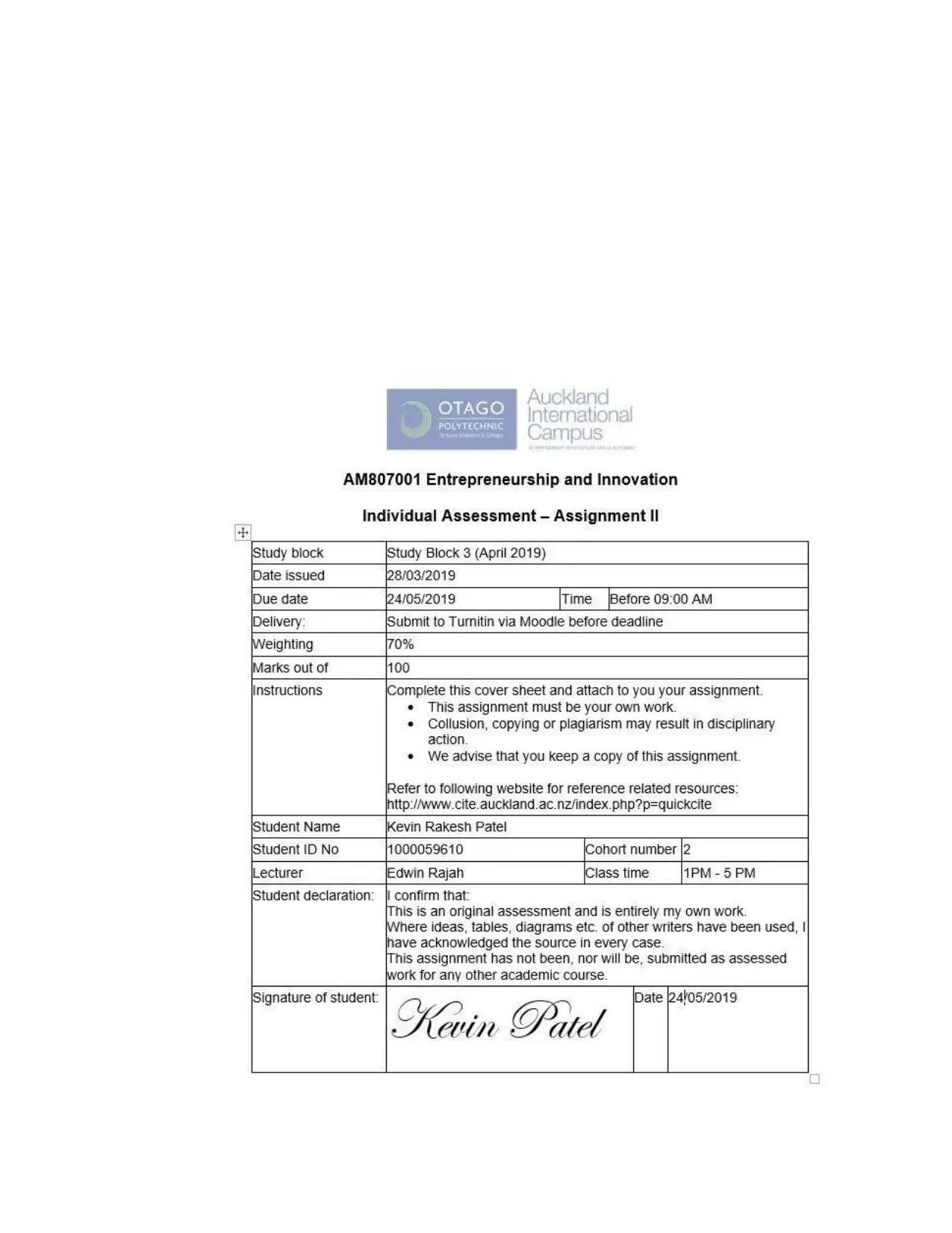
Paraphrase This Document
Need a fresh take? Get an instant paraphrase of this document with our AI Paraphraser
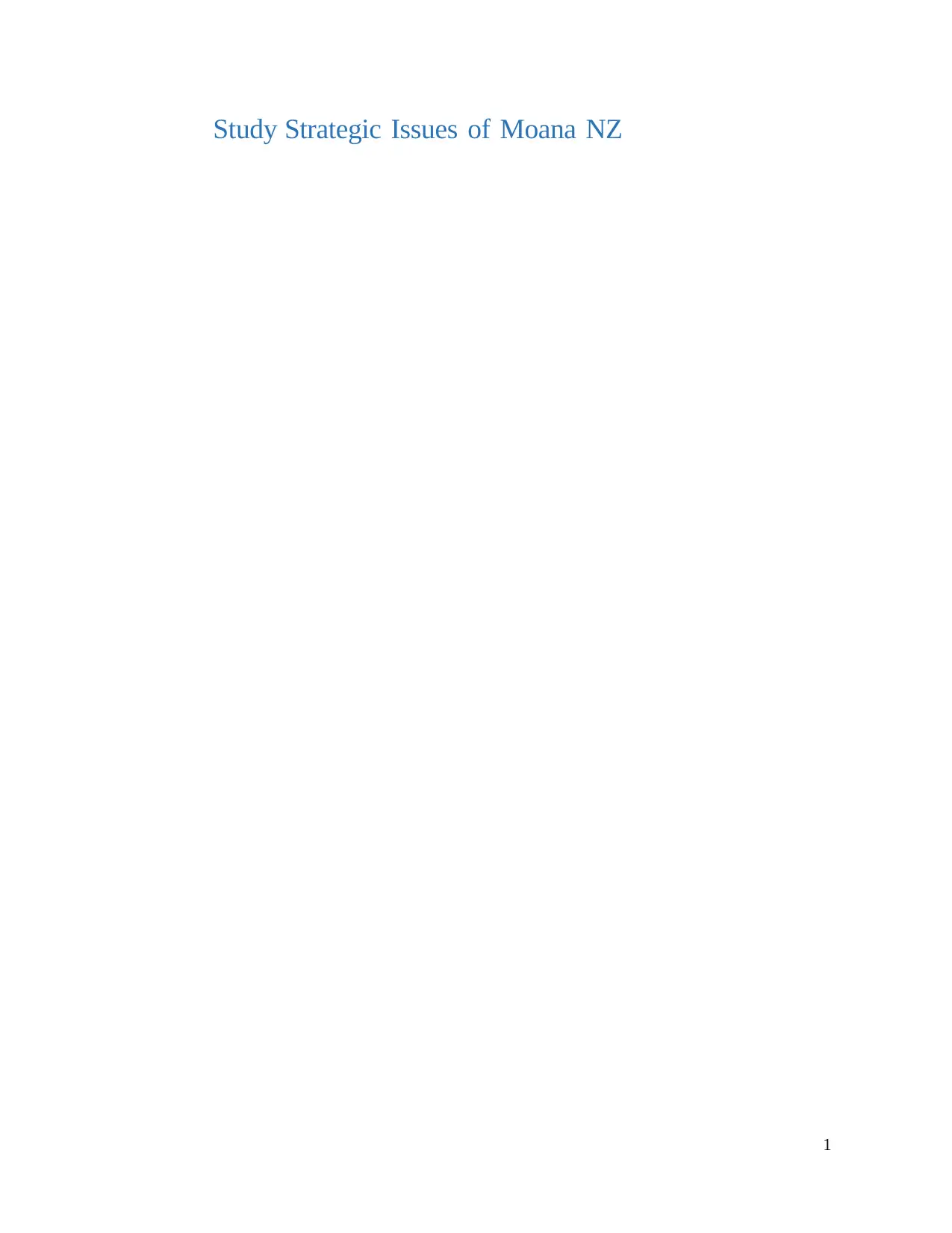
1
Study Strategic Issues of Moana NZ
Study Strategic Issues of Moana NZ
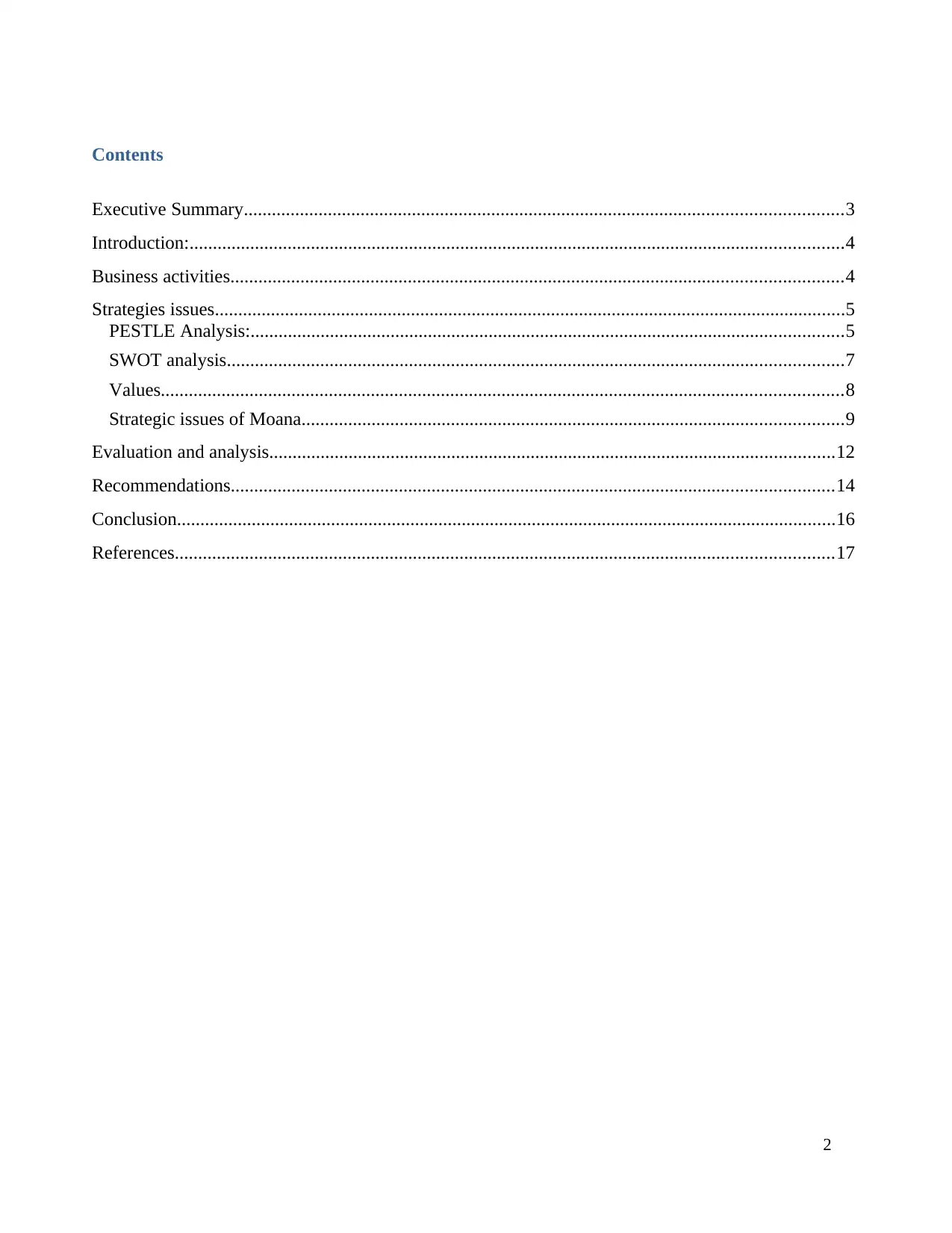
2
Contents
Executive Summary................................................................................................................................3
Introduction:............................................................................................................................................4
Business activities...................................................................................................................................4
Strategies issues.......................................................................................................................................5
PESTLE Analysis:...............................................................................................................................5
SWOT analysis....................................................................................................................................7
Values..................................................................................................................................................8
Strategic issues of Moana....................................................................................................................9
Evaluation and analysis.........................................................................................................................12
Recommendations.................................................................................................................................14
Conclusion.............................................................................................................................................16
References.............................................................................................................................................17
Contents
Executive Summary................................................................................................................................3
Introduction:............................................................................................................................................4
Business activities...................................................................................................................................4
Strategies issues.......................................................................................................................................5
PESTLE Analysis:...............................................................................................................................5
SWOT analysis....................................................................................................................................7
Values..................................................................................................................................................8
Strategic issues of Moana....................................................................................................................9
Evaluation and analysis.........................................................................................................................12
Recommendations.................................................................................................................................14
Conclusion.............................................................................................................................................16
References.............................................................................................................................................17
⊘ This is a preview!⊘
Do you want full access?
Subscribe today to unlock all pages.

Trusted by 1+ million students worldwide
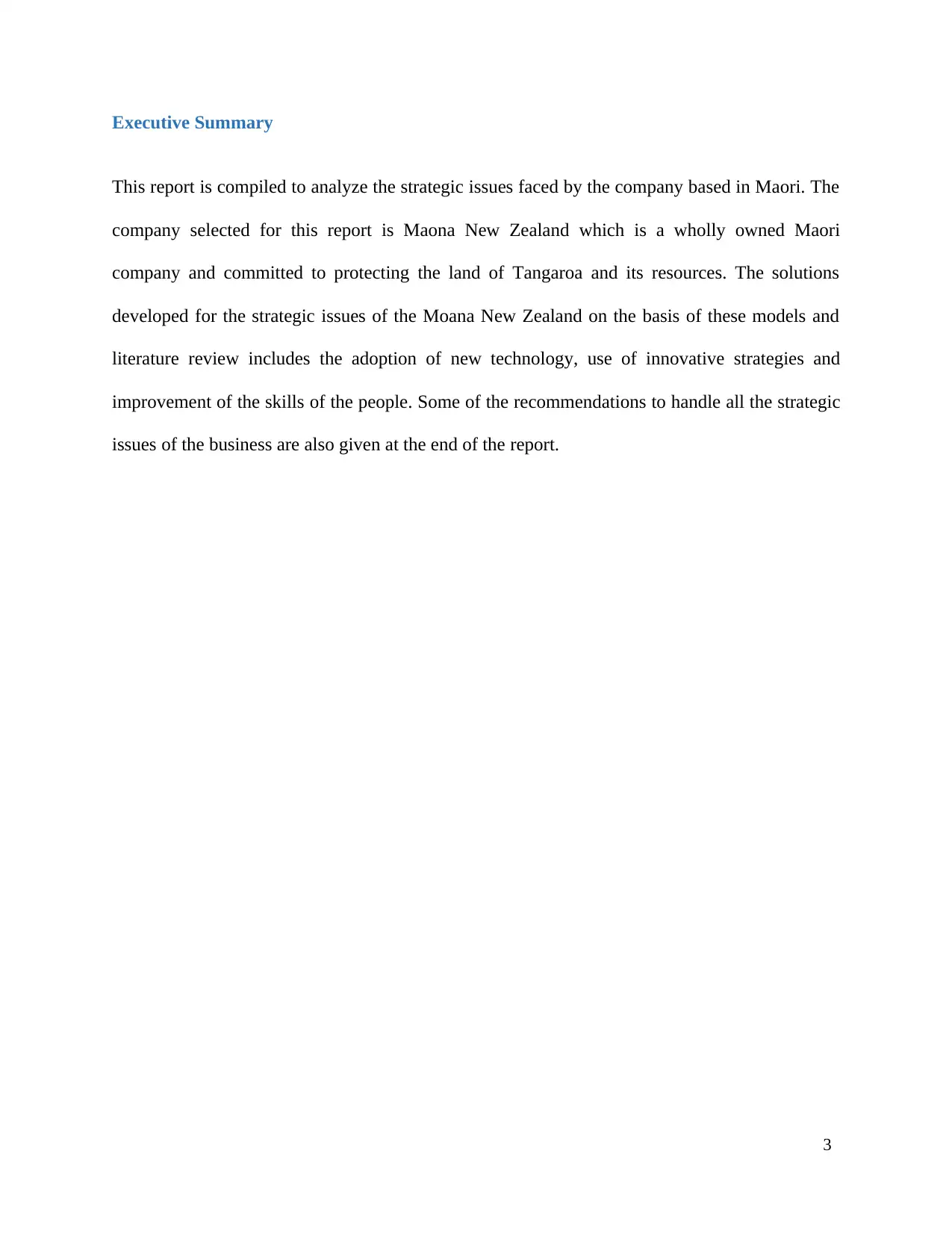
3
Executive Summary
This report is compiled to analyze the strategic issues faced by the company based in Maori. The
company selected for this report is Maona New Zealand which is a wholly owned Maori
company and committed to protecting the land of Tangaroa and its resources. The solutions
developed for the strategic issues of the Moana New Zealand on the basis of these models and
literature review includes the adoption of new technology, use of innovative strategies and
improvement of the skills of the people. Some of the recommendations to handle all the strategic
issues of the business are also given at the end of the report.
Executive Summary
This report is compiled to analyze the strategic issues faced by the company based in Maori. The
company selected for this report is Maona New Zealand which is a wholly owned Maori
company and committed to protecting the land of Tangaroa and its resources. The solutions
developed for the strategic issues of the Moana New Zealand on the basis of these models and
literature review includes the adoption of new technology, use of innovative strategies and
improvement of the skills of the people. Some of the recommendations to handle all the strategic
issues of the business are also given at the end of the report.
Paraphrase This Document
Need a fresh take? Get an instant paraphrase of this document with our AI Paraphraser
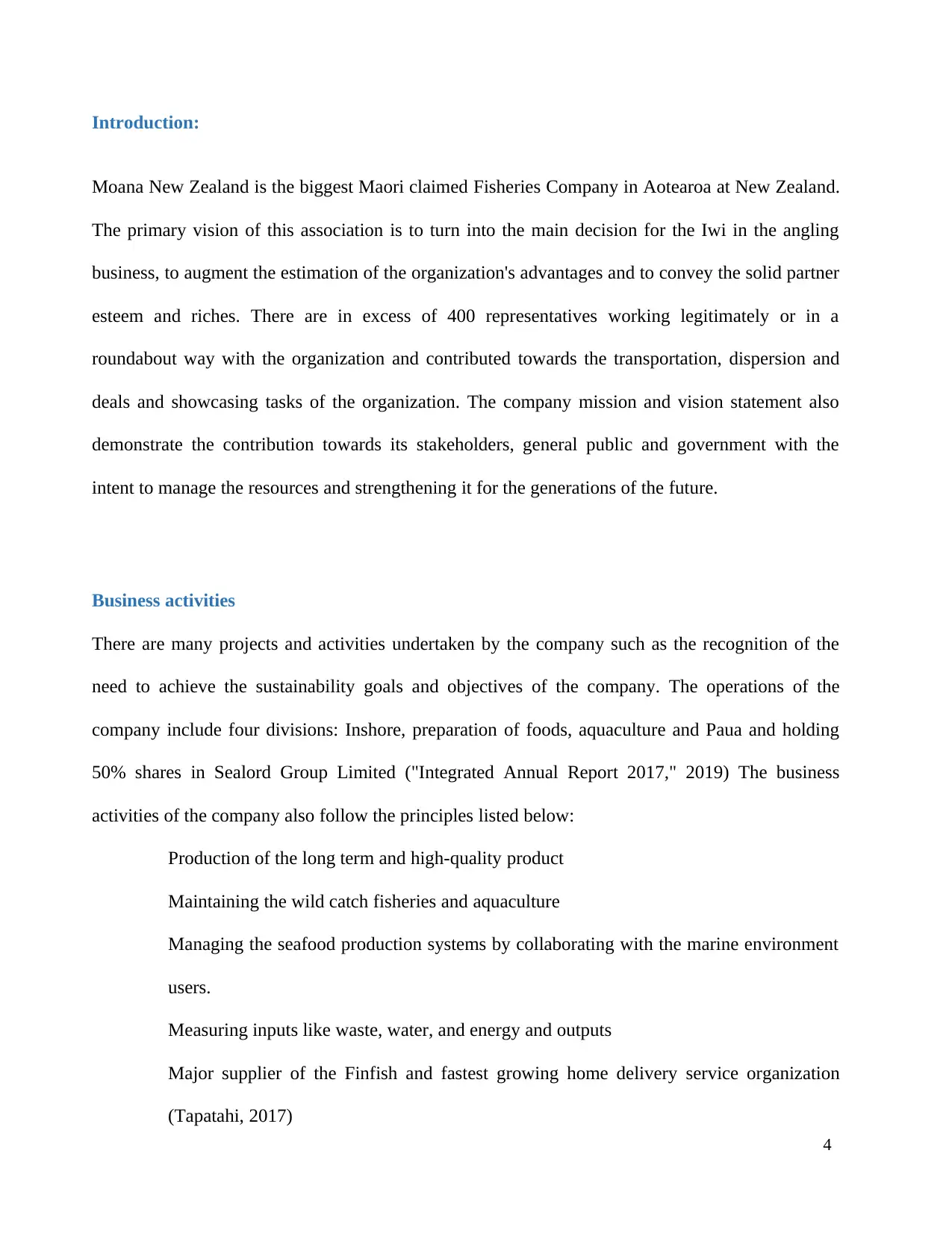
4
Introduction:
Moana New Zealand is the biggest Maori claimed Fisheries Company in Aotearoa at New Zealand.
The primary vision of this association is to turn into the main decision for the Iwi in the angling
business, to augment the estimation of the organization's advantages and to convey the solid partner
esteem and riches. There are in excess of 400 representatives working legitimately or in a
roundabout way with the organization and contributed towards the transportation, dispersion and
deals and showcasing tasks of the organization. The company mission and vision statement also
demonstrate the contribution towards its stakeholders, general public and government with the
intent to manage the resources and strengthening it for the generations of the future.
Business activities
There are many projects and activities undertaken by the company such as the recognition of the
need to achieve the sustainability goals and objectives of the company. The operations of the
company include four divisions: Inshore, preparation of foods, aquaculture and Paua and holding
50% shares in Sealord Group Limited ("Integrated Annual Report 2017," 2019) The business
activities of the company also follow the principles listed below:
Production of the long term and high-quality product
Maintaining the wild catch fisheries and aquaculture
Managing the seafood production systems by collaborating with the marine environment
users.
Measuring inputs like waste, water, and energy and outputs
Major supplier of the Finfish and fastest growing home delivery service organization
(Tapatahi, 2017)
Introduction:
Moana New Zealand is the biggest Maori claimed Fisheries Company in Aotearoa at New Zealand.
The primary vision of this association is to turn into the main decision for the Iwi in the angling
business, to augment the estimation of the organization's advantages and to convey the solid partner
esteem and riches. There are in excess of 400 representatives working legitimately or in a
roundabout way with the organization and contributed towards the transportation, dispersion and
deals and showcasing tasks of the organization. The company mission and vision statement also
demonstrate the contribution towards its stakeholders, general public and government with the
intent to manage the resources and strengthening it for the generations of the future.
Business activities
There are many projects and activities undertaken by the company such as the recognition of the
need to achieve the sustainability goals and objectives of the company. The operations of the
company include four divisions: Inshore, preparation of foods, aquaculture and Paua and holding
50% shares in Sealord Group Limited ("Integrated Annual Report 2017," 2019) The business
activities of the company also follow the principles listed below:
Production of the long term and high-quality product
Maintaining the wild catch fisheries and aquaculture
Managing the seafood production systems by collaborating with the marine environment
users.
Measuring inputs like waste, water, and energy and outputs
Major supplier of the Finfish and fastest growing home delivery service organization
(Tapatahi, 2017)
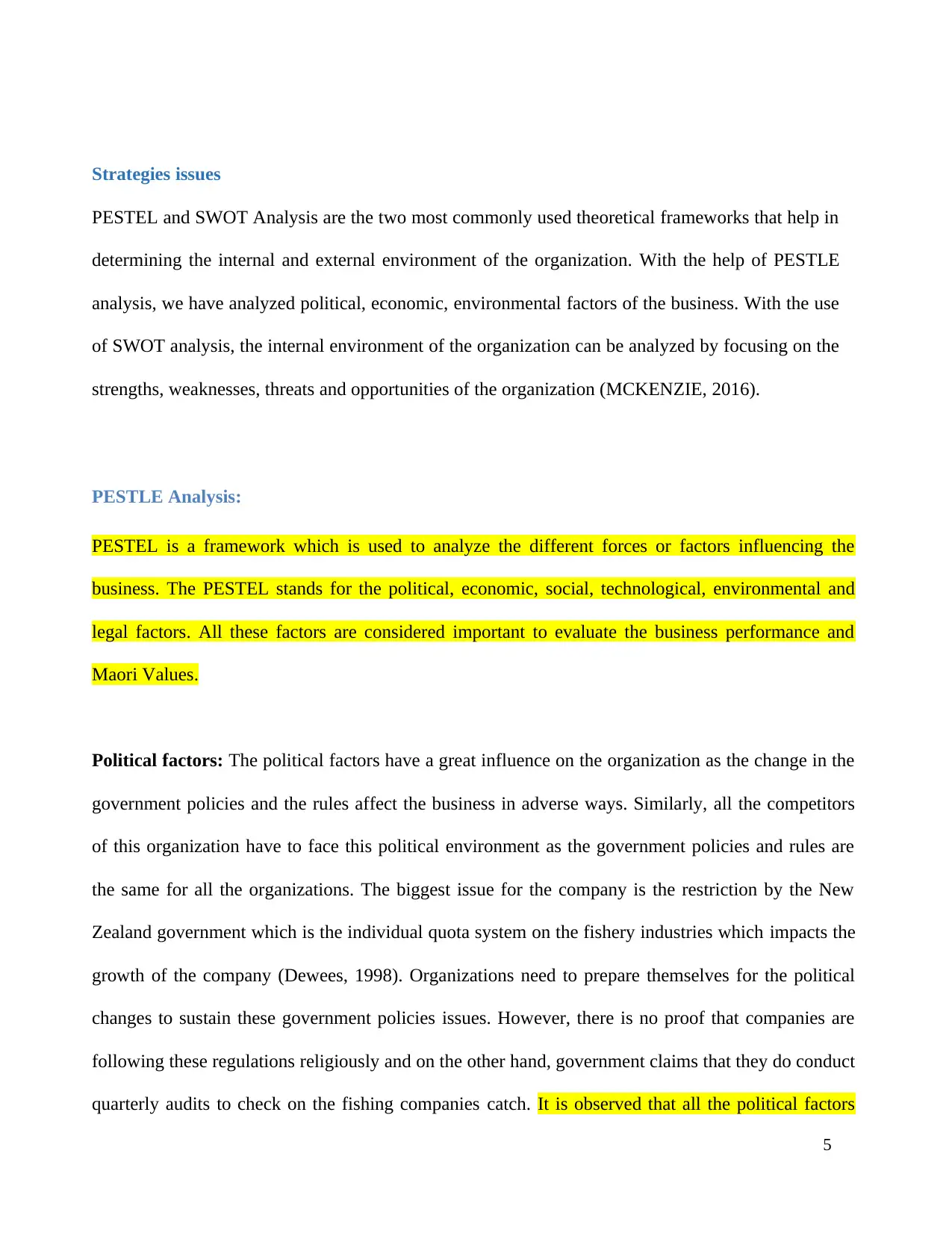
5
Strategies issues
PESTEL and SWOT Analysis are the two most commonly used theoretical frameworks that help in
determining the internal and external environment of the organization. With the help of PESTLE
analysis, we have analyzed political, economic, environmental factors of the business. With the use
of SWOT analysis, the internal environment of the organization can be analyzed by focusing on the
strengths, weaknesses, threats and opportunities of the organization (MCKENZIE, 2016).
PESTLE Analysis:
PESTEL is a framework which is used to analyze the different forces or factors influencing the
business. The PESTEL stands for the political, economic, social, technological, environmental and
legal factors. All these factors are considered important to evaluate the business performance and
Maori Values.
Political factors: The political factors have a great influence on the organization as the change in the
government policies and the rules affect the business in adverse ways. Similarly, all the competitors
of this organization have to face this political environment as the government policies and rules are
the same for all the organizations. The biggest issue for the company is the restriction by the New
Zealand government which is the individual quota system on the fishery industries which impacts the
growth of the company (Dewees, 1998). Organizations need to prepare themselves for the political
changes to sustain these government policies issues. However, there is no proof that companies are
following these regulations religiously and on the other hand, government claims that they do conduct
quarterly audits to check on the fishing companies catch. It is observed that all the political factors
Strategies issues
PESTEL and SWOT Analysis are the two most commonly used theoretical frameworks that help in
determining the internal and external environment of the organization. With the help of PESTLE
analysis, we have analyzed political, economic, environmental factors of the business. With the use
of SWOT analysis, the internal environment of the organization can be analyzed by focusing on the
strengths, weaknesses, threats and opportunities of the organization (MCKENZIE, 2016).
PESTLE Analysis:
PESTEL is a framework which is used to analyze the different forces or factors influencing the
business. The PESTEL stands for the political, economic, social, technological, environmental and
legal factors. All these factors are considered important to evaluate the business performance and
Maori Values.
Political factors: The political factors have a great influence on the organization as the change in the
government policies and the rules affect the business in adverse ways. Similarly, all the competitors
of this organization have to face this political environment as the government policies and rules are
the same for all the organizations. The biggest issue for the company is the restriction by the New
Zealand government which is the individual quota system on the fishery industries which impacts the
growth of the company (Dewees, 1998). Organizations need to prepare themselves for the political
changes to sustain these government policies issues. However, there is no proof that companies are
following these regulations religiously and on the other hand, government claims that they do conduct
quarterly audits to check on the fishing companies catch. It is observed that all the political factors
⊘ This is a preview!⊘
Do you want full access?
Subscribe today to unlock all pages.

Trusted by 1+ million students worldwide
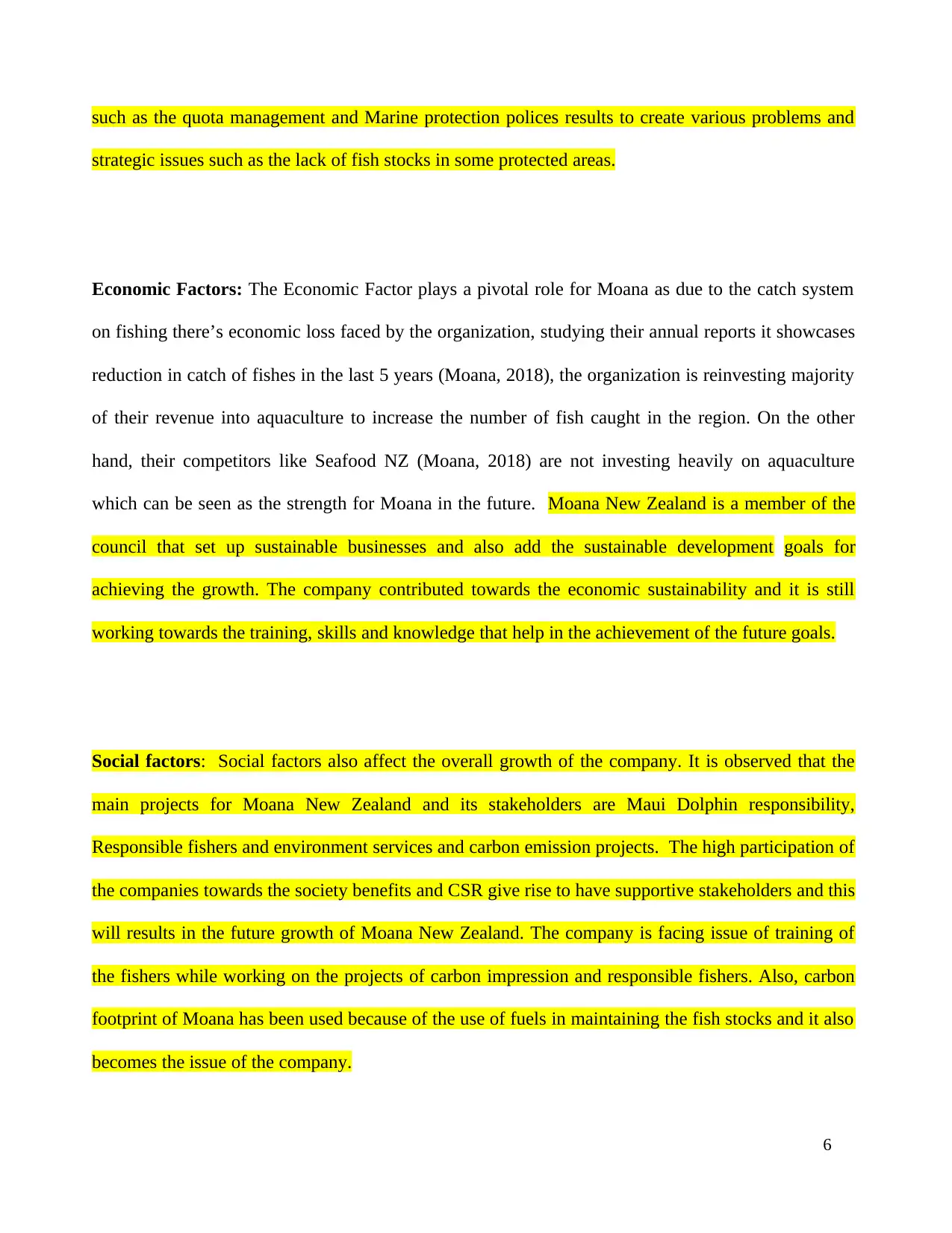
6
such as the quota management and Marine protection polices results to create various problems and
strategic issues such as the lack of fish stocks in some protected areas.
Economic Factors: The Economic Factor plays a pivotal role for Moana as due to the catch system
on fishing there’s economic loss faced by the organization, studying their annual reports it showcases
reduction in catch of fishes in the last 5 years (Moana, 2018), the organization is reinvesting majority
of their revenue into aquaculture to increase the number of fish caught in the region. On the other
hand, their competitors like Seafood NZ (Moana, 2018) are not investing heavily on aquaculture
which can be seen as the strength for Moana in the future. Moana New Zealand is a member of the
council that set up sustainable businesses and also add the sustainable development goals for
achieving the growth. The company contributed towards the economic sustainability and it is still
working towards the training, skills and knowledge that help in the achievement of the future goals.
Social factors: Social factors also affect the overall growth of the company. It is observed that the
main projects for Moana New Zealand and its stakeholders are Maui Dolphin responsibility,
Responsible fishers and environment services and carbon emission projects. The high participation of
the companies towards the society benefits and CSR give rise to have supportive stakeholders and this
will results in the future growth of Moana New Zealand. The company is facing issue of training of
the fishers while working on the projects of carbon impression and responsible fishers. Also, carbon
footprint of Moana has been used because of the use of fuels in maintaining the fish stocks and it also
becomes the issue of the company.
such as the quota management and Marine protection polices results to create various problems and
strategic issues such as the lack of fish stocks in some protected areas.
Economic Factors: The Economic Factor plays a pivotal role for Moana as due to the catch system
on fishing there’s economic loss faced by the organization, studying their annual reports it showcases
reduction in catch of fishes in the last 5 years (Moana, 2018), the organization is reinvesting majority
of their revenue into aquaculture to increase the number of fish caught in the region. On the other
hand, their competitors like Seafood NZ (Moana, 2018) are not investing heavily on aquaculture
which can be seen as the strength for Moana in the future. Moana New Zealand is a member of the
council that set up sustainable businesses and also add the sustainable development goals for
achieving the growth. The company contributed towards the economic sustainability and it is still
working towards the training, skills and knowledge that help in the achievement of the future goals.
Social factors: Social factors also affect the overall growth of the company. It is observed that the
main projects for Moana New Zealand and its stakeholders are Maui Dolphin responsibility,
Responsible fishers and environment services and carbon emission projects. The high participation of
the companies towards the society benefits and CSR give rise to have supportive stakeholders and this
will results in the future growth of Moana New Zealand. The company is facing issue of training of
the fishers while working on the projects of carbon impression and responsible fishers. Also, carbon
footprint of Moana has been used because of the use of fuels in maintaining the fish stocks and it also
becomes the issue of the company.
Paraphrase This Document
Need a fresh take? Get an instant paraphrase of this document with our AI Paraphraser
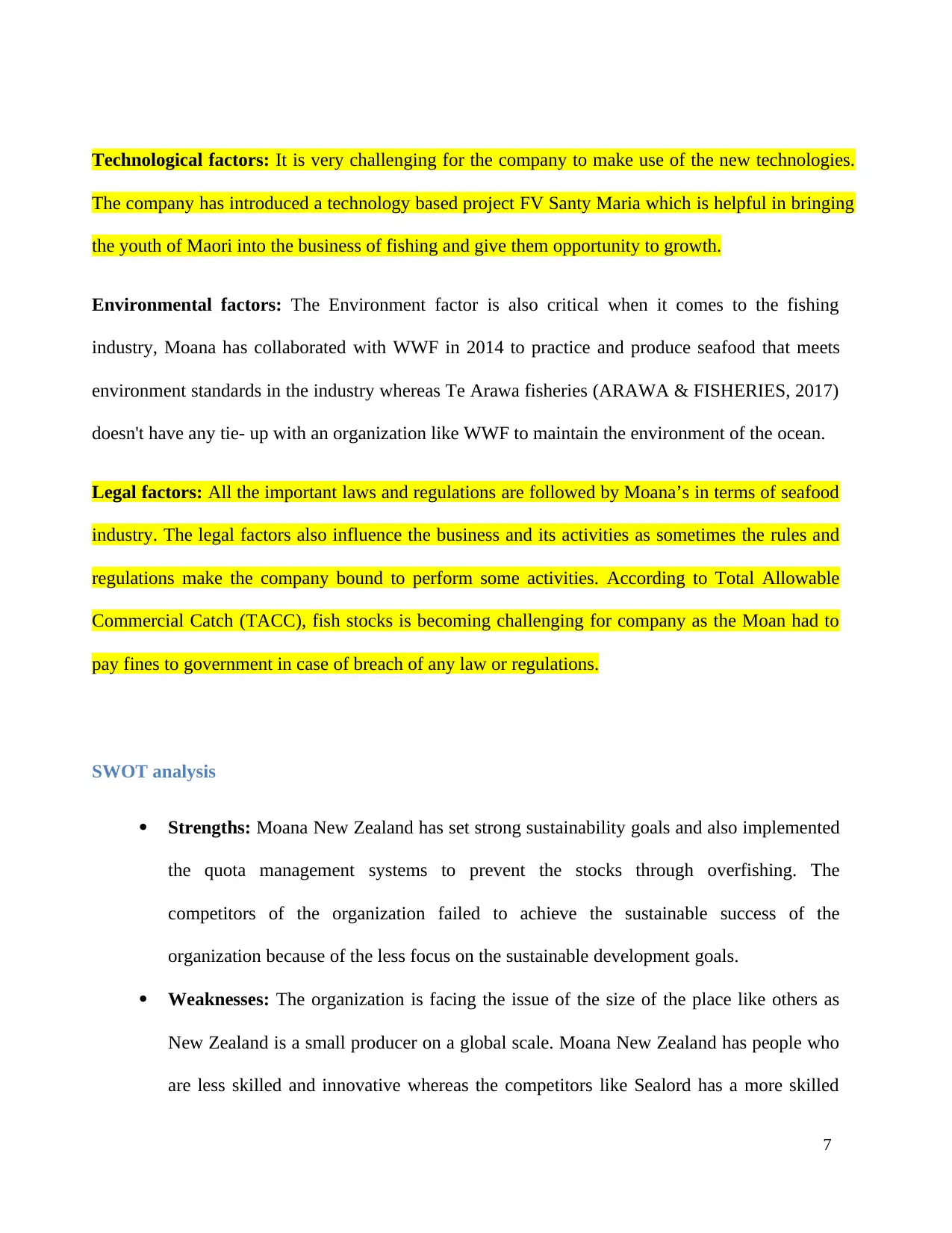
7
Technological factors: It is very challenging for the company to make use of the new technologies.
The company has introduced a technology based project FV Santy Maria which is helpful in bringing
the youth of Maori into the business of fishing and give them opportunity to growth.
Environmental factors: The Environment factor is also critical when it comes to the fishing
industry, Moana has collaborated with WWF in 2014 to practice and produce seafood that meets
environment standards in the industry whereas Te Arawa fisheries (ARAWA & FISHERIES, 2017)
doesn't have any tie- up with an organization like WWF to maintain the environment of the ocean.
Legal factors: All the important laws and regulations are followed by Moana’s in terms of seafood
industry. The legal factors also influence the business and its activities as sometimes the rules and
regulations make the company bound to perform some activities. According to Total Allowable
Commercial Catch (TACC), fish stocks is becoming challenging for company as the Moan had to
pay fines to government in case of breach of any law or regulations.
SWOT analysis
Strengths: Moana New Zealand has set strong sustainability goals and also implemented
the quota management systems to prevent the stocks through overfishing. The
competitors of the organization failed to achieve the sustainable success of the
organization because of the less focus on the sustainable development goals.
Weaknesses: The organization is facing the issue of the size of the place like others as
New Zealand is a small producer on a global scale. Moana New Zealand has people who
are less skilled and innovative whereas the competitors like Sealord has a more skilled
Technological factors: It is very challenging for the company to make use of the new technologies.
The company has introduced a technology based project FV Santy Maria which is helpful in bringing
the youth of Maori into the business of fishing and give them opportunity to growth.
Environmental factors: The Environment factor is also critical when it comes to the fishing
industry, Moana has collaborated with WWF in 2014 to practice and produce seafood that meets
environment standards in the industry whereas Te Arawa fisheries (ARAWA & FISHERIES, 2017)
doesn't have any tie- up with an organization like WWF to maintain the environment of the ocean.
Legal factors: All the important laws and regulations are followed by Moana’s in terms of seafood
industry. The legal factors also influence the business and its activities as sometimes the rules and
regulations make the company bound to perform some activities. According to Total Allowable
Commercial Catch (TACC), fish stocks is becoming challenging for company as the Moan had to
pay fines to government in case of breach of any law or regulations.
SWOT analysis
Strengths: Moana New Zealand has set strong sustainability goals and also implemented
the quota management systems to prevent the stocks through overfishing. The
competitors of the organization failed to achieve the sustainable success of the
organization because of the less focus on the sustainable development goals.
Weaknesses: The organization is facing the issue of the size of the place like others as
New Zealand is a small producer on a global scale. Moana New Zealand has people who
are less skilled and innovative whereas the competitors like Sealord has a more skilled
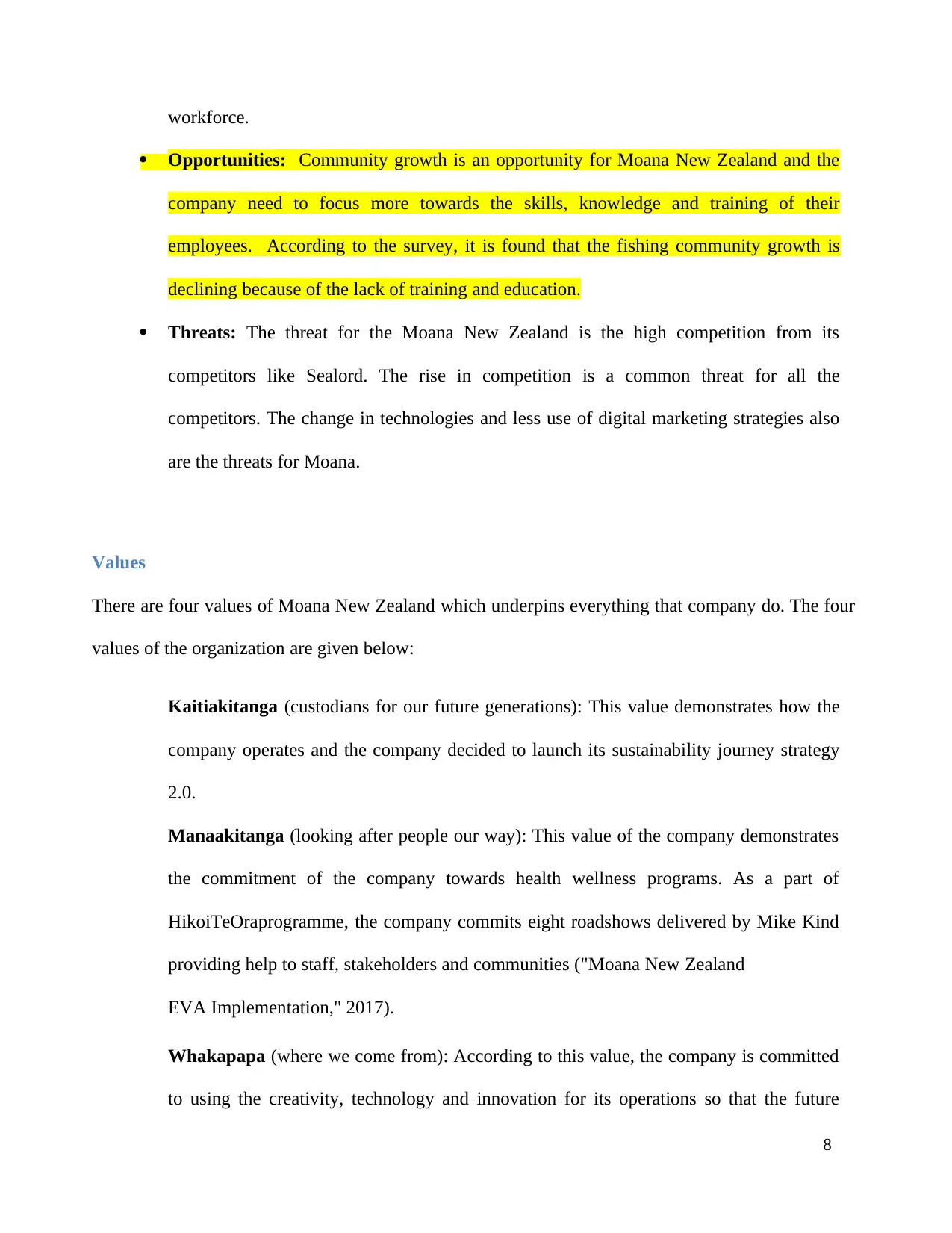
8
workforce.
Opportunities: Community growth is an opportunity for Moana New Zealand and the
company need to focus more towards the skills, knowledge and training of their
employees. According to the survey, it is found that the fishing community growth is
declining because of the lack of training and education.
Threats: The threat for the Moana New Zealand is the high competition from its
competitors like Sealord. The rise in competition is a common threat for all the
competitors. The change in technologies and less use of digital marketing strategies also
are the threats for Moana.
Values
There are four values of Moana New Zealand which underpins everything that company do. The four
values of the organization are given below:
Kaitiakitanga (custodians for our future generations): This value demonstrates how the
company operates and the company decided to launch its sustainability journey strategy
2.0.
Manaakitanga (looking after people our way): This value of the company demonstrates
the commitment of the company towards health wellness programs. As a part of
HikoiTeOraprogramme, the company commits eight roadshows delivered by Mike Kind
providing help to staff, stakeholders and communities ("Moana New Zealand
EVA Implementation," 2017).
Whakapapa (where we come from): According to this value, the company is committed
to using the creativity, technology and innovation for its operations so that the future
workforce.
Opportunities: Community growth is an opportunity for Moana New Zealand and the
company need to focus more towards the skills, knowledge and training of their
employees. According to the survey, it is found that the fishing community growth is
declining because of the lack of training and education.
Threats: The threat for the Moana New Zealand is the high competition from its
competitors like Sealord. The rise in competition is a common threat for all the
competitors. The change in technologies and less use of digital marketing strategies also
are the threats for Moana.
Values
There are four values of Moana New Zealand which underpins everything that company do. The four
values of the organization are given below:
Kaitiakitanga (custodians for our future generations): This value demonstrates how the
company operates and the company decided to launch its sustainability journey strategy
2.0.
Manaakitanga (looking after people our way): This value of the company demonstrates
the commitment of the company towards health wellness programs. As a part of
HikoiTeOraprogramme, the company commits eight roadshows delivered by Mike Kind
providing help to staff, stakeholders and communities ("Moana New Zealand
EVA Implementation," 2017).
Whakapapa (where we come from): According to this value, the company is committed
to using the creativity, technology and innovation for its operations so that the future
⊘ This is a preview!⊘
Do you want full access?
Subscribe today to unlock all pages.

Trusted by 1+ million students worldwide
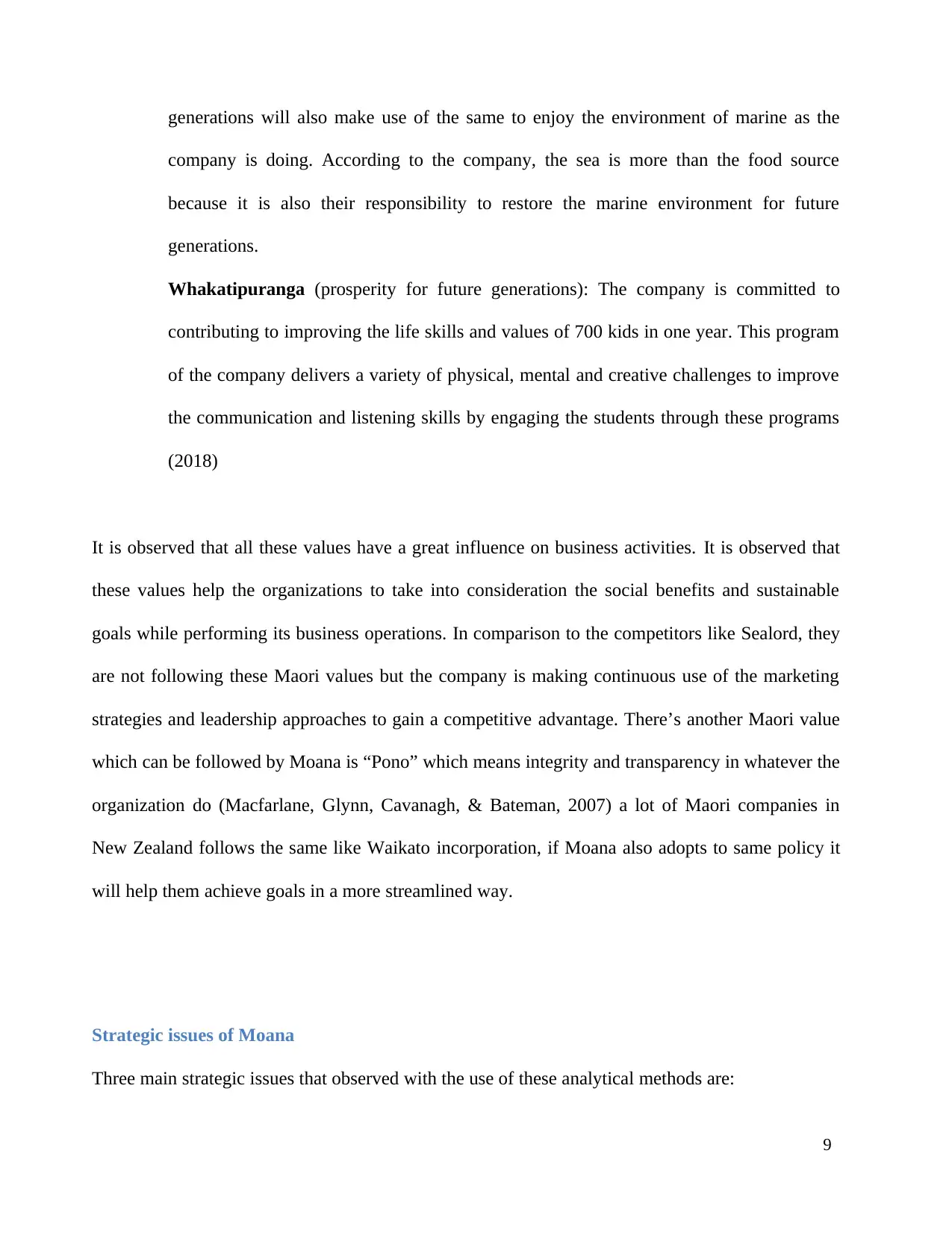
9
generations will also make use of the same to enjoy the environment of marine as the
company is doing. According to the company, the sea is more than the food source
because it is also their responsibility to restore the marine environment for future
generations.
Whakatipuranga (prosperity for future generations): The company is committed to
contributing to improving the life skills and values of 700 kids in one year. This program
of the company delivers a variety of physical, mental and creative challenges to improve
the communication and listening skills by engaging the students through these programs
(2018)
It is observed that all these values have a great influence on business activities. It is observed that
these values help the organizations to take into consideration the social benefits and sustainable
goals while performing its business operations. In comparison to the competitors like Sealord, they
are not following these Maori values but the company is making continuous use of the marketing
strategies and leadership approaches to gain a competitive advantage. There’s another Maori value
which can be followed by Moana is “Pono” which means integrity and transparency in whatever the
organization do (Macfarlane, Glynn, Cavanagh, & Bateman, 2007) a lot of Maori companies in
New Zealand follows the same like Waikato incorporation, if Moana also adopts to same policy it
will help them achieve goals in a more streamlined way.
Strategic issues of Moana
Three main strategic issues that observed with the use of these analytical methods are:
generations will also make use of the same to enjoy the environment of marine as the
company is doing. According to the company, the sea is more than the food source
because it is also their responsibility to restore the marine environment for future
generations.
Whakatipuranga (prosperity for future generations): The company is committed to
contributing to improving the life skills and values of 700 kids in one year. This program
of the company delivers a variety of physical, mental and creative challenges to improve
the communication and listening skills by engaging the students through these programs
(2018)
It is observed that all these values have a great influence on business activities. It is observed that
these values help the organizations to take into consideration the social benefits and sustainable
goals while performing its business operations. In comparison to the competitors like Sealord, they
are not following these Maori values but the company is making continuous use of the marketing
strategies and leadership approaches to gain a competitive advantage. There’s another Maori value
which can be followed by Moana is “Pono” which means integrity and transparency in whatever the
organization do (Macfarlane, Glynn, Cavanagh, & Bateman, 2007) a lot of Maori companies in
New Zealand follows the same like Waikato incorporation, if Moana also adopts to same policy it
will help them achieve goals in a more streamlined way.
Strategic issues of Moana
Three main strategic issues that observed with the use of these analytical methods are:
Paraphrase This Document
Need a fresh take? Get an instant paraphrase of this document with our AI Paraphraser
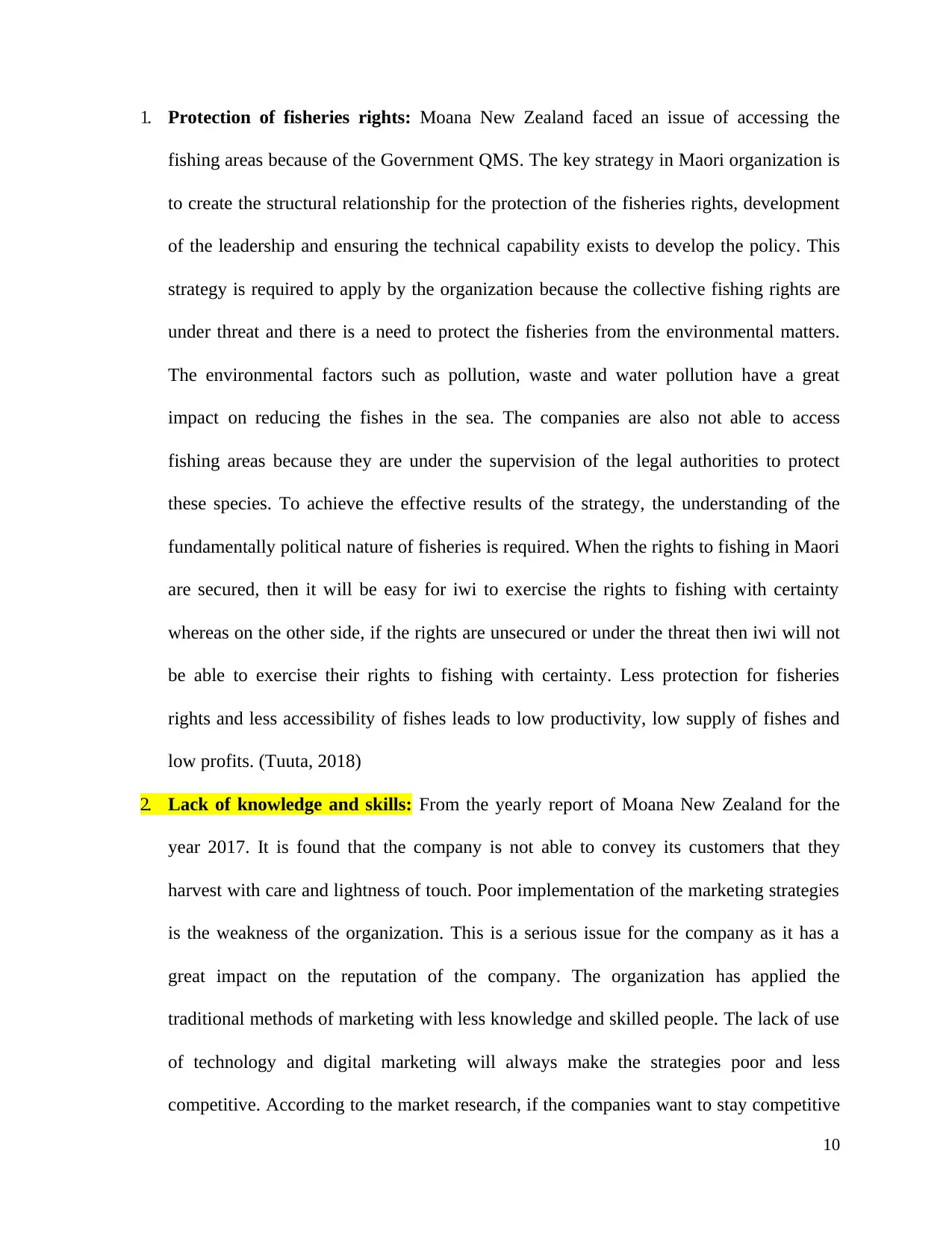
10
1. Protection of fisheries rights: Moana New Zealand faced an issue of accessing the
fishing areas because of the Government QMS. The key strategy in Maori organization is
to create the structural relationship for the protection of the fisheries rights, development
of the leadership and ensuring the technical capability exists to develop the policy. This
strategy is required to apply by the organization because the collective fishing rights are
under threat and there is a need to protect the fisheries from the environmental matters.
The environmental factors such as pollution, waste and water pollution have a great
impact on reducing the fishes in the sea. The companies are also not able to access
fishing areas because they are under the supervision of the legal authorities to protect
these species. To achieve the effective results of the strategy, the understanding of the
fundamentally political nature of fisheries is required. When the rights to fishing in Maori
are secured, then it will be easy for iwi to exercise the rights to fishing with certainty
whereas on the other side, if the rights are unsecured or under the threat then iwi will not
be able to exercise their rights to fishing with certainty. Less protection for fisheries
rights and less accessibility of fishes leads to low productivity, low supply of fishes and
low profits. (Tuuta, 2018)
2. Lack of knowledge and skills: From the yearly report of Moana New Zealand for the
year 2017. It is found that the company is not able to convey its customers that they
harvest with care and lightness of touch. Poor implementation of the marketing strategies
is the weakness of the organization. This is a serious issue for the company as it has a
great impact on the reputation of the company. The organization has applied the
traditional methods of marketing with less knowledge and skilled people. The lack of use
of technology and digital marketing will always make the strategies poor and less
competitive. According to the market research, if the companies want to stay competitive
1. Protection of fisheries rights: Moana New Zealand faced an issue of accessing the
fishing areas because of the Government QMS. The key strategy in Maori organization is
to create the structural relationship for the protection of the fisheries rights, development
of the leadership and ensuring the technical capability exists to develop the policy. This
strategy is required to apply by the organization because the collective fishing rights are
under threat and there is a need to protect the fisheries from the environmental matters.
The environmental factors such as pollution, waste and water pollution have a great
impact on reducing the fishes in the sea. The companies are also not able to access
fishing areas because they are under the supervision of the legal authorities to protect
these species. To achieve the effective results of the strategy, the understanding of the
fundamentally political nature of fisheries is required. When the rights to fishing in Maori
are secured, then it will be easy for iwi to exercise the rights to fishing with certainty
whereas on the other side, if the rights are unsecured or under the threat then iwi will not
be able to exercise their rights to fishing with certainty. Less protection for fisheries
rights and less accessibility of fishes leads to low productivity, low supply of fishes and
low profits. (Tuuta, 2018)
2. Lack of knowledge and skills: From the yearly report of Moana New Zealand for the
year 2017. It is found that the company is not able to convey its customers that they
harvest with care and lightness of touch. Poor implementation of the marketing strategies
is the weakness of the organization. This is a serious issue for the company as it has a
great impact on the reputation of the company. The organization has applied the
traditional methods of marketing with less knowledge and skilled people. The lack of use
of technology and digital marketing will always make the strategies poor and less
competitive. According to the market research, if the companies want to stay competitive
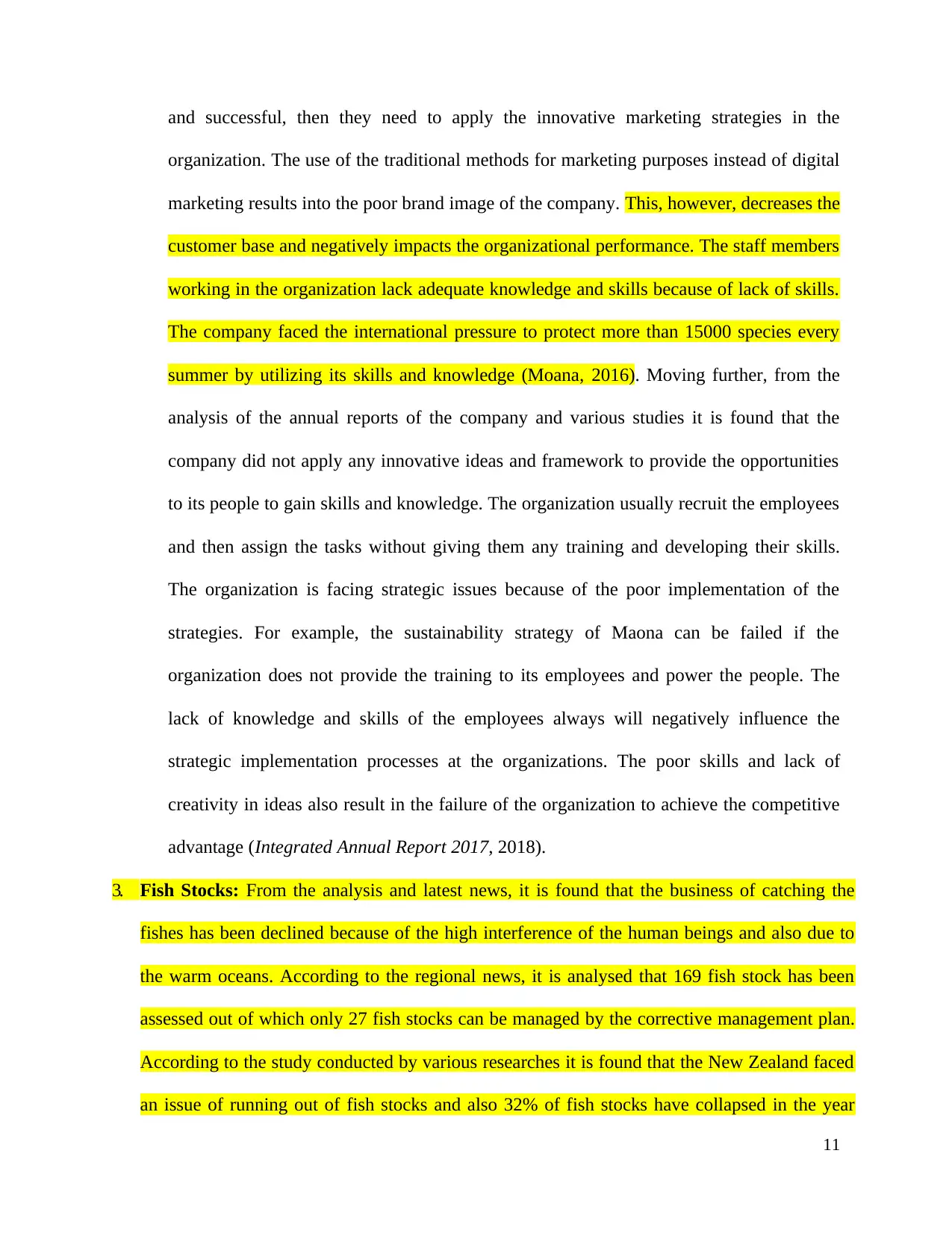
11
and successful, then they need to apply the innovative marketing strategies in the
organization. The use of the traditional methods for marketing purposes instead of digital
marketing results into the poor brand image of the company. This, however, decreases the
customer base and negatively impacts the organizational performance. The staff members
working in the organization lack adequate knowledge and skills because of lack of skills.
The company faced the international pressure to protect more than 15000 species every
summer by utilizing its skills and knowledge (Moana, 2016). Moving further, from the
analysis of the annual reports of the company and various studies it is found that the
company did not apply any innovative ideas and framework to provide the opportunities
to its people to gain skills and knowledge. The organization usually recruit the employees
and then assign the tasks without giving them any training and developing their skills.
The organization is facing strategic issues because of the poor implementation of the
strategies. For example, the sustainability strategy of Maona can be failed if the
organization does not provide the training to its employees and power the people. The
lack of knowledge and skills of the employees always will negatively influence the
strategic implementation processes at the organizations. The poor skills and lack of
creativity in ideas also result in the failure of the organization to achieve the competitive
advantage (Integrated Annual Report 2017, 2018).
3. Fish Stocks: From the analysis and latest news, it is found that the business of catching the
fishes has been declined because of the high interference of the human beings and also due to
the warm oceans. According to the regional news, it is analysed that 169 fish stock has been
assessed out of which only 27 fish stocks can be managed by the corrective management plan.
According to the study conducted by various researches it is found that the New Zealand faced
an issue of running out of fish stocks and also 32% of fish stocks have collapsed in the year
and successful, then they need to apply the innovative marketing strategies in the
organization. The use of the traditional methods for marketing purposes instead of digital
marketing results into the poor brand image of the company. This, however, decreases the
customer base and negatively impacts the organizational performance. The staff members
working in the organization lack adequate knowledge and skills because of lack of skills.
The company faced the international pressure to protect more than 15000 species every
summer by utilizing its skills and knowledge (Moana, 2016). Moving further, from the
analysis of the annual reports of the company and various studies it is found that the
company did not apply any innovative ideas and framework to provide the opportunities
to its people to gain skills and knowledge. The organization usually recruit the employees
and then assign the tasks without giving them any training and developing their skills.
The organization is facing strategic issues because of the poor implementation of the
strategies. For example, the sustainability strategy of Maona can be failed if the
organization does not provide the training to its employees and power the people. The
lack of knowledge and skills of the employees always will negatively influence the
strategic implementation processes at the organizations. The poor skills and lack of
creativity in ideas also result in the failure of the organization to achieve the competitive
advantage (Integrated Annual Report 2017, 2018).
3. Fish Stocks: From the analysis and latest news, it is found that the business of catching the
fishes has been declined because of the high interference of the human beings and also due to
the warm oceans. According to the regional news, it is analysed that 169 fish stock has been
assessed out of which only 27 fish stocks can be managed by the corrective management plan.
According to the study conducted by various researches it is found that the New Zealand faced
an issue of running out of fish stocks and also 32% of fish stocks have collapsed in the year
⊘ This is a preview!⊘
Do you want full access?
Subscribe today to unlock all pages.

Trusted by 1+ million students worldwide
1 out of 19
Related Documents
Your All-in-One AI-Powered Toolkit for Academic Success.
+13062052269
info@desklib.com
Available 24*7 on WhatsApp / Email
![[object Object]](/_next/static/media/star-bottom.7253800d.svg)
Unlock your academic potential
Copyright © 2020–2025 A2Z Services. All Rights Reserved. Developed and managed by ZUCOL.





